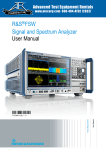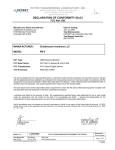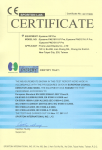Download PDF 1.3 MB
Transcript
TEST REPORT FROM: COMMUNICATION CERTIFICATION LABORATORY TEST OF: LCU-1 & UCU-1 To EN 55022: 1998 FCC Part 15, Subpart B ICES-003 Test Report Serial No: 73-7852 TEST REPORT FROM: COMMUNICATION CERTIFICATION LABORATORY 1940 W. Alexander Street Salt Lake City, Utah 84119-2039 Type of Report: Declaration of Conformity TEST OF: LCU-1 & UCU-1 To EN 55022: 1998 FCC Part 15, Subpart B ICES-003 Test Report Serial No: 73-7852 Applicant: MotoSat 2343 South 2300 West Salt Lake City, UT 84119 Date of Test: February 19, 2003 Issue Date: February 19, 2003 Equipment Receipt Date: February 19, 2003 COMMUNICATION CERTIFICATION LABORATORY TEST REPORT: 73-7852 ISSUE DATE: 02/19/2003 Page 2 of 30 CERTIFICATION OF ENGINEERING REPORT This report has been prepared by Communication Certification Laboratory to document compliance of the device described below with the Class B requirements of EN 55022: 1998, Federal Communications Commission (FCC) Part 15, Subpart B and Industry Canada (IC) ICES-003. This report may be reproduced in full, partial reproduction may only be made with the written consent of the laboratory. The results in this report apply only to the sample tested. - Applicant: MotoSat - Manufacturer: MotoSat - Brand Name: DataStorm - Model Number: LCU-1 & UCU-1 On this 19th day of February 2003, I, individually, and for Communication Certification Laboratory, certify that the statements made in this engineering report are true, complete, and correct to the best of my knowledge, and are made in good faith. Although NVLAP has recognized that the Communication Certification Laboratory EMC testing facilities are in good standing, NVLAP does not endorse the product described in this report. COMMUNICATION CERTIFICATION LABORATORY Checked by: Kirk Thomas V.P. Engineering Tested by: Norman P. Hansen EMC Technician COMMUNICATION CERTIFICATION LABORATORY TEST REPORT: 73-7852 ISSUE DATE: 02/19/2003 Page 3 of 30 TABLE OF CONTENTS PAGE SECTION 1.0 CLIENT INFORMATION.................................4 SECTION 2.0 EQUIPMENT UNDER TEST (EUT)..........................5 SECTION 3.0 TEST SPECIFICATION, METHODS & PROCEDURES...........7 SECTION 4.0 OPERATION OF EUT DURING TESTING...................11 SECTION 5.0 SUMMARY OF TEST RESULTS...........................13 SECTION 6.0 MEASUREMENTS, EXAMINATIONS AND DERIVED RESULTS.....14 APPENDIX 1 TEST PROCEDURES AND TEST EQUIPMENT..................17 APPENDIX 2 PHOTOGRAPHS.........................................21 APPENDIX 3 FCC Part 15/ICES-003 CONDUCTED DISTURBANCE DATA.....27 APPENDIX 4 FCC Part 15/ICES-003 COMPLIANCE INFORMATION.........28 COMMUNICATION CERTIFICATION LABORATORY TEST REPORT: 73-7852 ISSUE DATE: 02/19/2003 Page 4 of 30 SECTION 1.0 CLIENT INFORMATION 1.1 Applicant: Company Name: MotoSat 2343 South 2300 West Salt Lake City, UT 84119 Contact Name: Title: Edward C. Travis Engineering Manager 1.2 Manufacturer: Company Name: MotoSat 2343 South 2300 West Salt Lake City, UT 84119 Contact Name: Title: Edward C. Travis Engineering Manager 1.3 Party Responsible for Declaration of Conformity: Company Name: MotoSat 2343 South 2300 West Salt Lake City, UT 84119 Contact Name: Title: Edward C. Travis Engineering Manager Signature: COMMUNICATION CERTIFICATION LABORATORY TEST REPORT: 73-7852 ISSUE DATE: 02/19/2003 Page 5 of 30 SECTION 2.0 EQUIPMENT UNDER TEST (EUT) 2.1 Identification of EUT: Brand Name: Model Name or Number: Serial Number: Options Fitted: DataStorm LCU-1 & UCU-1 None N/A 2.2 Description of EUT: The LCU-1 is a controller for positioning and monitoring a mobile satellite antenna. The UCU-1 is mounted to the mobile satellite antenna and provides interfacing to the sensors and positioning motors for the satellite antenna. 12 VDC, typically a vehicle battery, is used to power both the LCU-1 and the UCU-1 and there is no provision for connection to any AC mains. 2.3 EUT and Support Equipment: The FCC ID numbers for all the EUT and support equipment used during the test (including inserted cards) are listed below: Brand Name Model Number BN: DataStorm FCC ID Number Description Name of Interface Ports / Interface Cables N/A Controller See Section 2.4 N/A Controller See Section 2.4 DoC Laptop Computer N/A Mobile Satellite Antenna Serial/Unshielded cable w/DB9 & DB15 connectors (2) Motor Control/ Unshielded cable (2) MN: LCU-1 (1) BN: DataStorm MN: UCU-1 (1) BN: HP Pavilion MN: N5420 BN: DataStorm MN: Satellite Antenna Note: (1) EUT. (2) Interface port connected to EUT (See Section 2.4) The support equipment listed above was not modified in order to achieve compliance with this standard. COMMUNICATION CERTIFICATION LABORATORY TEST REPORT: 73-7852 ISSUE DATE: 02/19/2003 Page 6 of 30 2.4 Interface Ports on EUT: LCU-1 Interface Ports Name of Ports No. of Ports Fitted to EUT. Power 1 Motor Control 1 Serial 1 Signal 1 Cable Descriptions/Length Unshielded 2 conductor cable/5 meters Unshielded 9 conductor cable/10 meters Unshielded cable w/DB9 and DB15 connectos/3 meters RG6 coax w/F-type connectors terminated in 75Ω/1 meter UCU-1 Interface Port Name of Port No. of Ports Fitted to EUT. Cable Descriptions/Length Data (To LCU-1) 1 Motor Control 1 Unshielded 9 conductor cable/10 meters Unshielded cable/<1 meter 2.5 Modification Incorporated/Special Accessories on EUT: There were no modifications or special accessories required to comply with the specification. Signature: Typed Name: Edward C. Travis Title: Engineering Manager COMMUNICATION CERTIFICATION LABORATORY TEST REPORT: 73-7852 ISSUE DATE: 02/19/2003 Page 7 of 30 SECTION 3.0 TEST SPECIFICATION, METHODS & PROCEDURES 3.1 Test Specification: Title: EN 55022: 1998 Information technology equipment – Radio disturbance characteristics – Limits and methods of measurement. Purpose of Test: The tests were performed to demonstrate initial compliance. 3.2 Methods & Procedures: 3.2.1 Limits for Conducted Disturbance at Mains Terminals and Telecommunication Ports The equipment under test (EUT) shall meet the limits in Tables 1 and 3 or 2 and 4, as applicable, including the average limit and the quasi-peak limit when using, respectively, an average detector receiver and a quasi-peak detector receiver and measured in accordance with the methods described in Clause 9. Either the voltage limits or the current limits in table 3 or 4, as applicable, shall be met except for the measurement method of C.1.3 where both limits shall be met. If the average limit is met when using a quasi-peak detector receiver, the EUT shall be deemed to meet both limits and measurement with the average detector receiver is unnecessary. If the reading on the measuring receiver shows fluctuations close to the limit the reading shall be observed for at least 15 s at each measurement frequency; the highest reading shall be recorded with the exception of any brief isolated high reading which shall be ignored. Table 1 - Limits for conducted disturbance at mains ports of Class A ITE. Frequency range (MHz) 0.15 to 0.50 0.50 to 30 Limits (dBµV) Quasi-peak Average 79 73 66 60 NOTE – The lower limit shall apply at the transition frequency COMMUNICATION CERTIFICATION LABORATORY TEST REPORT: 73-7852 ISSUE DATE: 02/19/2003 Page 8 of 30 Table 2 - Limits for conducted disturbance at mains ports of Class B ITE. Frequency range (MHz) 0.15 to 0.50 0.50 to 5 5 to 30 Limits (dBµV) Quasi-peak Average 66 to 56 56 60 56 to 46 46 50 NOTE 1 – The lower limit shall apply at the transition frequencies. NOTE 2 – The limit decreases linearly with the logarithm of the frequency in the range 0.15 MHz to 0.50 MHz. Table 3 - Limits of conducted common mode (asymmetric mode) disturbance at telecommunication ports in the frequency range 0.15 MHz to 30 MHz for Class A equipment. Frequency range (MHz) 0.15 to 0.5 0.5 to 30 Voltage Limits (dBµV) Quasi-peak Average 97 to 87 84 to 74 87 74 Current Limits (dBµA) Quasi-peak Average 53 to 43 40 to 30 43 30 NOTE 1 – The limit decreases linearly with the logarithm of the frequency in the range 0.15 MHz to 0.50 MHz. NOTE 2 – The current and voltage disturbance limits are derived for use with an impedance stabilization network (ISN) which presents a common mode (asymmetric mode) impedance of 150 Ω to the telecommunication port under test (conversion factor is 20 log10 150/I = 44 dB). COMMUNICATION CERTIFICATION LABORATORY TEST REPORT: 73-7852 ISSUE DATE: 02/19/2003 Page 9 of 30 Table 4 - Limits of conducted common mode (asymmetric mode) disturbance at telecommunication ports in the frequency range 0.15 MHz to 30 MHz for Class B equipment. Frequency range (MHz) 0.15 to 0.5 0.5 to 30 Voltage Limits (dBµV) Quasi-peak Average 84 to 74 74 to 64 74 64 Current Limits (dBµA) Quasi-peak Average 40 to 30 30 to 20 30 20 NOTE 1 – The limit decreases linearly with the logarithm of the frequency in the range 0.15 MHz to 0.50 MHz. NOTE 2 – The current and voltage disturbance limits are derived for use with an impedance stabilization network (ISN) which presents a common mode (asymmetric mode) impedance of 150 Ω to the telecommunication port under test (conversion factor is 20 log10 150/I = 44 dB). NOTE 3 – Provisionally, a relaxation of 10 dB over the frequency range of 6 MHz to 30 MHz is allowed for high-speed services having significant spectral density in this band. However, this relaxation is restricted to the common mode disturbance converted by the cable from the wanted signal. The provisional relaxation of 10 dB will be reviewed no later than three years after the date of withdrawal based on the results and interference cases seen in this period. Whenever possible it is recommended to comply with the limits without the provisional relaxation. 3.2.2 Limits for Radiated Disturbance The EUT shall meet the limits of Tables 5 or 6 when measured at the measuring distance R in accordance with the methods described in clause 10. If the reading on the measuring receiver shows fluctuations close to the limit, the reading shall be observed for at least 15 s at each measurement frequency; the highest reading shall be recorded with the exception of any brief isolated high reading, which shall be ignored. Table 5 - Limits for radiated disturbance of Class A ITE at a test distance of 10 m. Frequency range (MHz) Quasi-peak limits (dBµV/m) 30 to 230 230 to 1000 40 47 NOTE 1 - The lower limit shall apply at the transition frequency. NOTE 2 – Additional provisions may be required for cases where interference occurs. COMMUNICATION CERTIFICATION LABORATORY TEST REPORT: 73-7852 ISSUE DATE: 02/19/2003 Page 10 of 30 Table 6 - Limits for radiated disturbance of Class B ITE at a test distance of 10 m. Frequency range (MHz) Quasi-peak limits (dBµV/m) 30 to 230 230 to 1000 30 37 NOTE 1 - The lower limit shall apply at the transition frequency. NOTE 2 – Additional provisions may be required for cases where interference occurs. 3.2.3 Test Procedure The conducted disturbance at mains and telecommunications ports and radiated disturbance testing was performed according to the procedures in EN 55022: 1998, Sections 8 through 10. Testing was performed at CCL’s Wanship open area test site #2, located at 550 West Wanship Road, Wanship, UT. This site has been fully described in a report submitted to the FCC, and was accepted in a letter dated October 23, 2000 (90504). CCL is accredited by National Voluntary Laboratory Accreditation Program (NVLAP); NVLAP Lab Code:100272-0, which is effective until September 30, 2003. For radiated disturbance testing that is performed at distances closer than the specified distance; an inverse proportionality factor of 20 dB per decade is used to normalize the measured data for determining compliance. COMMUNICATION CERTIFICATION LABORATORY TEST REPORT: 73-7852 ISSUE DATE: 02/19/2003 Page 11 of 30 SECTION 4.0 OPERATION OF EUT DURING TESTING 4.1 Operating Environment: Power Supply: 12 VDC 4.2 Operating Modes: Each mode of operation was exercised to produce worst-case emissions. The worst-case emissions were with the LCU-1 & UCU-1 running in the following mode. The UCU-1 was mounted on the DataStorm Satellite Antenna and connected to the positioning motors and sensors. The LCU-1 was connected to the UCU-1 and the laptop computer. The buses were active passing positioning data between the laptop, LCU-1, and UCU-1. 4.3 EUT Exercise Software: MotoSat software was used to exercise the EUT. 4.4 Configuration & Peripherals: The LCU-1 & UCU-1 was placed on the table and connected to the support equipment listed in Section 2.3 via each port listed in Section 2.4. Shown in Section 4.5 is a block diagram of the test configuration. COMMUNICATION CERTIFICATION LABORATORY TEST REPORT: 73-7852 ISSUE DATE: 02/19/2003 Page 12 of 30 4.5 Block Diagram of Test Configuration: To Laptop Computer and 12VDC Source LCU-1 UCU-1 Satellite Antenna EUT Table COMMUNICATION CERTIFICATION LABORATORY TEST REPORT: 73-7852 ISSUE DATE: 02/19/2003 Page 13 of 30 SECTION 5.0 SUMMARY OF TEST RESULTS 5.1 Tables 2, 4 and 6 (Class B) of EN 55022: 1998 5.1.1 Summary of Tests: Port Frequency Range (MHz) Result Conducted Disturbance (Hot Lead to Ground) 0.15 to 30 Not Applicable Conducted Disturbance (Neutral Lead to Ground) 0.15 to 30 Telecommunication Port Conducted Common Mode (asymmetric mode) Disturbance 0.15 to 30 Enclosure Radiated Disturbance (Vertical Polarity) 30 to 1000 Complied Enclosure Radiated Disturbance (Horizontal Polarity) 30 to 1000 Complied AC Power AC Power Environmental Phenomena (Note 1) Not Applicable (Note 1) Not Applicable (Note 2) Note 1: There is no provision for operating the EUT from AC mains power; therefore, this test is not applicable. Note 2: There are no telecommunication ports on the EUT; therefore, this test is not applicable. 5.2 Result In the configuration tested, the EUT complied with the requirements of the specification. COMMUNICATION CERTIFICATION LABORATORY TEST REPORT: 73-7852 ISSUE DATE: 02/19/2003 Page 14 of 30 SECTION 6.0 MEASUREMENTS, EXAMINATIONS AND DERIVED RESULTS 6.1 General Comments: This section contains the test results only. Details of the test methods used and a list of the test equipment used during the measurements can be found in Appendix 1 of this report. 6.2 Test Results: 6.2.1 Radiated Disturbance Data (Vertical Polarity) Frequency (MHz) Detector Receiver Reading (dBµV) Correction Factor (dB/m) Field Strength (dBµV/m) Class B 10 m Limit (dBµV/m) Margin (dB) 60.4 Peak (Note 1) 12.9 7.8 20.7 30.0 -9.3 72.3 Peak (Note 1) 14.6 7.3 21.9 30.0 -8.1 138.0 Peak (Note 1) 15.3 8.3 23.6 30.0 -6.4 208.8 Peak (Note 1) 9.4 11.6 21.0 30.0 -9.0 228.8 Peak (Note 1) 11.2 12.9 24.1 30.0 -5.9 256.0 Peak (Note 1) 18.0 13.8 31.8 37.0 -5.2 259.2 Peak (Note 1) 14.4 13.9 28.3 37.0 -8.7 422.4 Peak (Note 1) 12.0 19.0 31.0 37.0 -6.0 435.2 Peak (Note 1) 10.6 19.2 29.8 37.0 -7.2 Note 1: The reference detector used for the measurements was peak or quasipeak and the data was compared to the quasi-peak limit. Measurement Uncertainty The measurement uncertainty (with a 95% confidence level) for this test was: ± 4.3 dB (30 MHz to 200 MHz) and ± 6.0 dB @ 3 meters ± 2.7 dB @ 10 meters (200 MHz to 1 GHz). RESULT The EUT complied with the specification limit by a margin of 5.2 dB. COMMUNICATION CERTIFICATION LABORATORY TEST REPORT: 73-7852 ISSUE DATE: 02/19/2003 Page 15 of 30 6.2.2 Radiated Disturbance Data (Horizontal Polarity) Frequency (MHz) Detector Receiver Reading (dBµV) Correction Factor (dB/m) Field Strength (dBµV/m) Class B 10 m Limit (dBµV/m) Margin (dB) 137.8 Peak (Note 1) 13.9 8.3 22.2 30.0 -7.8 256.0 Peak (Note 1) 16.3 13.8 30.1 37.0 -6.9 360.0 Peak (Note 1) 12.5 18.1 30.6 37.0 -6.4 372.8 Peak (Note 1) 12.6 18.5 31.1 37.0 -5.9 385.6 Peak (Note 1) 14.6 18.7 33.3 37.0 -3.7 396.8 Peak (Note 1) 13.2 18.8 32.0 37.0 -5.0 411.2 Peak (Note 1) 13.7 18.9 32.6 37.0 -4.4 422.4 Peak (Note 1) 11.9 19.0 30.9 37.0 -6.1 435.2 Peak (Note 1) 13.8 19.2 33.0 37.0 -4.0 444.8 Peak (Note 1) 10.9 19.6 30.5 37.0 -6.5 Note 1: The reference detector used for the measurements was peak or quasipeak and the data was compared to the quasi-peak limit. Measurement Uncertainty The measurement uncertainty (with a 95% confidence level) for this test was: ± 4.3 dB (30 MHz to 200 MHz) and ± 6.0 dB @ 3 meters ± 2.7 dB @ 10 meters (200 MHz to 1 GHz). RESULT The EUT complied with the specification limit by a margin of 3.7 dB. COMMUNICATION CERTIFICATION LABORATORY TEST REPORT: 73-7852 ISSUE DATE: 02/19/2003 Page 16 of 30 6.3 Sample Field Strength Calculation: The field strength is calculated by adding the Correction Factor (Antenna Factor + Cable Factor), to the measured level from the receiver. The receiver amplitude reading is compensated for any amplifier gain. The basic equation with a sample calculation is shown below: FS = RA + CF Where FS = Field Strength RA = Receiver Amplitude Reading (Receiver Reading Amplifier Gain) CF = Correction Factor (Antenna Factor + Cable Factor) Assume a receiver reading of 42.5 dBµV is obtained from the receiver, an amplifier gain of 26.5 dB and a correction factor of 8.5 dB/m. The field strength is calculated by subtracting the amplifier gain and adding the correction factor, giving a field strength of 24.5 dBµV/m, FS = (42.5 - 26.5) + 8.5 = 24.5 dBµV/m COMMUNICATION CERTIFICATION LABORATORY TEST REPORT: 73-7852 ISSUE DATE: 02/19/2003 Page 17 of 30 APPENDIX 1 TEST PROCEDURES AND TEST EQUIPMENT Conducted Disturbance at Mains and Telecommunications Ports: The conducted disturbance at mains and telecommunications ports from the ITE was measured using a spectrum analyzer with a quasi-peak adapter for peak, quasi-peak and average readings. The quasi-peak adapter uses a bandwidth of 9 kHz, with the spectrum analyzer's resolution bandwidth set at 100 kHz, for readings in the 150 kHz to 30 MHz frequency ranges. The conducted disturbance at mains and telecommunications ports measurements are performed in a screen room using a (50 Ω/50 µH) Line Impedance Stabilization Network (LISN). Where mains flexible power cords are longer than 1 m, the excess cable is folded back and forth as far as possible so as to form a bundle not exceeding 0.4 m in length. Where the EUT is a collection of ITE with each ITE having its own power cord, the point of connection for the LISN is determined from the following rules: a) Each power cord, which is terminated in a mains supply plug, shall be tested separately. b) Power cords, which are not specified by the manufacturer to be connected via a host unit, shall be tested separately. c) Power cords which are specified by the manufacturer to be connected via a host unit or other power supplying equipment shall be connected to that host unit and the power cords of that host unit connected to the LISN and tested. d) Where a special connection is specified, the necessary hardware to effect the connection is supplied by the manufacturer for the testing purpose. e) When testing equipment with multiple mains cords, those cords not under test are connected to an artificial mains network (AMN) different than the AMN used for the mains cord under test. For AC mains port testing the desktop ITE are placed on a non-conducting table at least 0.8 meters from the metallic floor, and for telecommunications port testing the desktop ITE are placed on a non-conducting table at least 0.4 meters from the metallic floor. The equipment is placed a minimum of 40 cm from all walls. Floor standing equipment is placed directly on the earth grounded floor. COMMUNICATION CERTIFICATION LABORATORY TEST REPORT: 73-7852 ISSUE DATE: 02/19/2003 Page 18 of 30 Type of Equipment Manufacturer Model Number Serial Number Date of Last Calibration Wanship Open Area Test Site #2 CCL N/A N/A 12/31/2002 Test Software CCL Conducted Emissions Revision 1.2 N/A Spectrum Analyzer Hewlett Packard 8566B 2230A01711 10/01/2002 Quasi-Peak Detector Hewlett Packard 8565A 3107A01582 10/02/2002 LISN EMCO 3825/2 9305-2099 01/27/2003 Conductance Cable Wanship Site #2 CCL Cable J N/A 12/31/2002 Transient Limiter Hewlett Packard 11947A 3107A02266 12/31/2002 An independent calibration laboratory or CCL personnel calibrates all the equipment listed above every 12 months following outlined calibration procedures. All measurement instrumentation is traceable to the National Institute of Standards and Technology (NIST). Supporting documentation relative to tractability is on file and is available for examination upon request. Conducted Emissions Test Setup Printer Screened Room Computer LISN Transient Limiter Spectrum Analyzer COMMUNICATION CERTIFICATION LABORATORY TEST REPORT: 73-7852 ISSUE DATE: 02/19/2003 Page 19 of 30 Radiated Disturbance: The radiated disturbance from the ITE was measured using a spectrum analyzer with a quasi-peak adapter for peak and quasi-peak readings. A preamplifier with a fixed gain of 26 dB and a power amplifier with a fixed gain of 22 dB were used to increase the sensitivity of the measuring instrumentation. The quasi-peak adapter uses a bandwidth of 120 kHz, with the spectrum analyzer's resolution bandwidth set at 1 MHz, for readings in the 30 to 1000 MHz frequency ranges. A biconilog antenna was used to measure the frequency range of 30 to 1000 MHz, at a distance of 10 meters from the EUT. The readings obtained by these antennas are correlated to the levels obtained with a tuned dipole antenna by adding antenna factors. The configuration of the ITE was varied to find the maximum radiated emission. The EUT was connected to the peripherals listed in Section 2.4 via the interconnecting cables listed in Section 2.5. A technician manually manipulated these interconnecting cables to obtain worst-case radiated disturbance. The ITE was rotated 360 degrees, and the antenna height was varied from 1 to 4 meters to find the maximum radiated emission. Where there was multiple interface ports all of the same type, cables are either placed on all of the ports or cables added to these ports until the emissions do not increase by more than 2 dB. Desktop ITE is measured on a non-conducting table 0.8 meters above the ground plane. The table is placed on a turntable, which is level with the ground plane. For equipment normally placed on floors, the equipment shall be placed directly on the turntable. Type of Equipment Manufacturer Model Number Serial Number Date of Last Calibration Wanship Open Area Test Site #2 CCL N/A N/A 12/31/2002 Test Software CCL Radiated Emissions Revision 1.3 N/A Spectrum Analyzer Hewlett Packard 8566B 2230A01711 10/01/2002 Quasi-Peak Detector Hewlett Packard 8565A 3107A01582 10/02/2002 Biconilog Antenna EMCO 3142 9601-1009 12/30/2002 COMMUNICATION CERTIFICATION LABORATORY TEST REPORT: 73-7852 ISSUE DATE: 02/19/2003 Page 20 of 30 Type of Equipment Manufacturer Model Number Serial Number Date of Last Calibration 10 Meter Radiated Emissions Cable Wanship Site #2 CCL Cable L N/A 12/31/2002 Pre/PowerAmplifier Hewlett Packard 8447F 3113A05161 09/19/2002 6 dB Attenuator Hewlett Packard 8491A 32835 12/31/2002 An independent calibration laboratory or CCL personnel calibrates all the equipment listed above every 12 months following outlined calibration procedures. All measurement instrumentation is traceable to the National Institute of Standards and Technology (NIST). Supporting documentation relative to tractability is on file and is available for examination upon request. Radiated Emissions Test Setup Printer Open Area Test Site Computer Antenna EUT 6dB Attenuator Turntable Pre/Power Amp Spectrum Analyzer COMMUNICATION CERTIFICATION LABORATORY TEST REPORT: 73-7852 ISSUE DATE: 02/19/2003 Page 21 of 30 APPENDIX 2 PHOTOGRAPHS Photograph 1 – Front View Radiated Disturbance Worst Case Configuration COMMUNICATION CERTIFICATION LABORATORY TEST REPORT: 73-7852 ISSUE DATE: 02/19/2003 Page 22 of 30 Photograph 2 – Back View Radiated Disturbance Worst Case Configuration COMMUNICATION CERTIFICATION LABORATORY TEST REPORT: 73-7852 ISSUE DATE: 02/19/2003 Page 23 of 30 Photograph 3 – Front View of the LCU-1 COMMUNICATION CERTIFICATION LABORATORY TEST REPORT: 73-7852 ISSUE DATE: 02/19/2003 Page 24 of 30 Photograph 4 – Back View of the LCU-1 COMMUNICATION CERTIFICATION LABORATORY TEST REPORT: 73-7852 ISSUE DATE: 02/19/2003 Page 25 of 30 Photograph 5 – Internal View of the LCU-1 COMMUNICATION CERTIFICATION LABORATORY TEST REPORT: 73-7852 ISSUE DATE: 02/19/2003 Page 26 of 30 Photograph 6 – View of the UCU-1 mounted to the DataStorm Antenna COMMUNICATION CERTIFICATION LABORATORY TEST REPORT: 73-7852 ISSUE DATE: 02/19/2003 Page 27 of 30 APPENDIX 3 FCC Part 15/ICES-003 CONDUCTED DISTURBANCE AT MAINS PORTS DATA There is no provision for operating the EUT from AC mains power; therefore, these tests are not applicable. COMMUNICATION CERTIFICATION LABORATORY TEST REPORT: 73-7852 ISSUE DATE: 02/19/2003 Page 28 of 30 APPENDIX 4 FCC Part 15/ICES-003 COMPLIANCE INFORMATION A.4.1 LABEL AND COMPLIANCE STATEMENT The label of the MotoSat DataStorm LCU-1 & UCU-1 were not available at the time of this report. Below are the FCC labeling requirements: Section 15.17(a) (3) All other devices shall bear the following statement in a conspicuous location on the device: This device complies with Part 15 of the FCC Rules. Operation is subject to the following two conditions: (1) this device may not cause harmful interference, and (2) this device must accept any interference received, including interference that may cause undesired operation. (4) Where a device is constructed in two or more sections connected by wires and marketed together, the statement specified under paragraph (a) of this section is required to be affixed only to the main control unit. Section 15.17(b) (4) The label shall not be a stick-on, paper label. The label on these products shall be permanently affixed to the product and shall be readily visible to the purchaser at the time of purchase, as described in Section 2.925(d) of this chapter. "Permanently affixed" means that the label is etched, engraved, stamped, silkscreened, indelibly printed, or otherwise permanently marked on a permanently attached part of the equipment or on a nameplate of metal, plastic, or other material fastened to the equipment by welding, riveting, or a permanent adhesive. The label must be designed to last the expected lifetime of the equipment in the environment in which the equipment may be operated and must not be readily detachable. COMMUNICATION CERTIFICATION LABORATORY TEST REPORT: 73-7852 ISSUE DATE: 02/19/2003 Page 29 of 30 A.4.2 BLOCK DIAGRAM A block diagram showing the clock frequencies and signal paths of the MotoSat DataStorm LCU-1 & UCU-1 were not available at the time of this report. COMMUNICATION CERTIFICATION LABORATORY TEST REPORT: 73-7852 ISSUE DATE: 02/19/2003 Page 30 of 30 A.4.3 USER’S MANUAL A copy of the User’s manual containing the FCC warning statement was not available at the time of this report. Sample of Class B Warning Statement NOTE: This equipment has been tested and found to comply with the limits for a Class B digital device pursuant to part 15 of the FCC Rules. These limits are designed to provide reasonable protection against harmful interference in a residential installation. This equipment generates, uses and can radiated radio frequency energy and, if not installed and used in accordance with the instructions, may cause harmful interference to radio communications. However, there is no guarantee that interference will not occur in a particular installation. If this equipment does cause harmful interference to radio or television reception, which can be determined by turning the equipment off and on, the user is encouraged to try to correct the interference by one or more of the following measures: - Reorient or relocate the receiving antenna. - Increase the separation between the equipment and receiver. - Connect the equipment into an outlet on a circuit different from that to which the receiver is connected. Consult the dealer or an experienced radio/TV technician for help.
































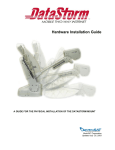
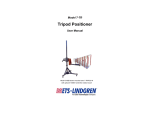
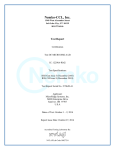
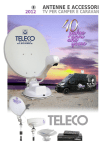
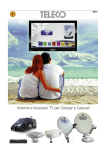
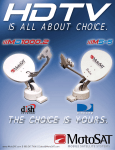
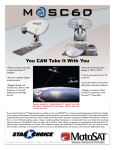


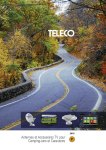
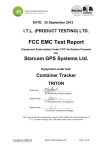


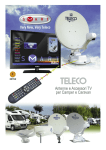
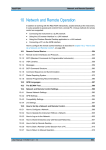
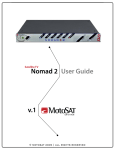
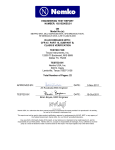
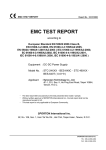
![TECNARE DPA 28X OWNER [Ingles]](http://vs1.manualzilla.com/store/data/005945802_1-b9e6af5d2577bc9a733b6f858960f622-150x150.png)
